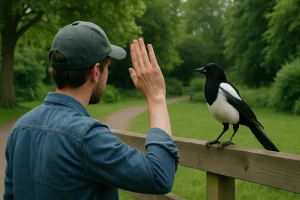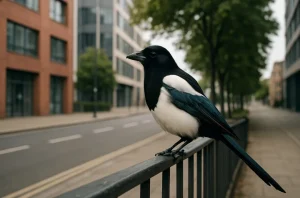Why do people in the UK salute a magpie? Why is this simple gesture, often performed without hesitation, so deeply rooted in tradition? The practice may appear to be nothing more than a quirky habit, but behind it lies centuries of folklore, superstition, and cultural belief.
From nursery rhymes to rituals meant to ward off bad luck, the act of saluting a lone magpie continues to fascinate.
Even in modern Britain, where science and logic dominate daily life, this old custom remains surprisingly resilient. To understand why people still salute magpies today, we must explore its origins, symbolism, and ongoing relevance.
What Is the Origin of Saluting a Magpie?

The tradition of saluting magpies can be traced back to British folklore, where birds were often believed to be messengers of fate.
Among these, magpies stood out because of their dual reputation for both good and bad fortune. Their striking black-and-white plumage represented opposites: joy and sorrow, life and death, luck and misfortune.
In some regions of England, a lone magpie was thought to be unlucky because magpies were social birds. Seeing one alone suggested loss, absence, or imbalance.
To counteract this perceived misfortune, people developed rituals such as saluting, tipping a hat, or verbally greeting the bird. The underlying idea was simple: by acknowledging the magpie respectfully, a person could avoid attracting its bad influence.
The habit became widespread in the eighteenth and nineteenth centuries, particularly after the rise of popular rhymes and folk songs that cemented the bird’s reputation in cultural memory. Over time, the salute evolved into one of Britain’s most recognised superstitions.
How Did the Rhyme “One for Sorrow” Influence the Tradition?
The superstition of saluting magpies is inseparable from the well-known rhyme “One for Sorrow.” This rhyme, recorded in various forms since the late eighteenth century, assigns different meanings to the number of magpies a person might encounter. The most common version is still familiar to many today.
Table: Variations of the “One for Sorrow” Rhyme
| Number of Magpies | Traditional Meaning | Alternative Variation |
| One | Sorrow / Bad luck | Bad news ahead |
| Two | Joy / Good luck | Happiness |
| Three | A girl | A birth |
| Four | A boy | A blessing |
| Five | Silver | Riches |
| Six | Gold | Treasure |
| Seven | A secret | A mystery |
| Eight | Heaven / A wish | Hope |
The rhyme strongly shaped popular beliefs. A lone magpie symbolised sorrow, while two promised joy. To counter the negative meaning of one, people began using gestures such as saluting. This ritual became an everyday method of neutralising what the rhyme suggested.
Why Do People Salute a Magpie for Luck?

The salute itself functions as a charm against misfortune. While its exact origins are debated, the gesture has long been associated with politeness and respect, especially in military or formal settings. Transferring this behaviour to a bird reflects the belief that a magpie should be honoured to avoid attracting its ill will.
Most commonly, people salute a magpie with the right hand while offering a verbal greeting such as “Good morning, Mr Magpie.” In some regions, additional words are spoken, such as “How’s your wife and children?”
This phrase is particularly symbolic because the sight of a lone magpie represents absence; by asking after its family, the observer metaphorically restores balance and avoids sorrow.
These acts are not merely whimsical. For many, they provide reassurance in uncertain moments. Even if performed out of habit, the gesture offers a sense of control over unseen forces.
What Does the Magpie Symbolise in British Folklore?
Magpies occupy a complex role in folklore. Their symbolism reflects both admiration and suspicion.
In Britain, they were often associated with sorrow, trickery, or theft, possibly because of their reputation for collecting shiny objects. Their appearance in rural areas, often near human settlements, strengthened their connection with human life and its fortunes.
Yet magpies were not universally negative. In Scotland, for example, seeing two magpies together was considered a sign of good fortune.
In Norse mythology, magpies were linked to cunning and adaptability, qualities that could be both positive and dangerous. In contrast, Chinese folklore treats magpies as bringers of joy, with their song believed to announce good news.
This duality highlights why magpies are so prominent in superstition: they embody the tension between good and bad, making them powerful symbols of fate.
How Is Saluting Magpies Practised in Modern Times?
Although fewer people today hold strong beliefs in superstition, the tradition of saluting magpies persists across the UK. Many children are introduced to the rhyme through school or family, and they quickly pick up the habit of saluting the bird.
For some, it becomes a playful ritual, while for others it remains a serious attempt to ward off misfortune.
The salute is not limited to rural areas. Even in urban environments, where magpies are common, people can be seen discreetly acknowledging the bird. This persistence shows how traditions adapt and survive, even in societies that place value on science and reason.
Television programmes, literature, and music have also played a role in keeping the tradition alive. By embedding the magpie salute into popular culture, these references ensure that new generations remain familiar with the practice.
Are Magpie Superstitions Still Relevant Today?

The relevance of magpie superstitions depends largely on perspective. Surveys into British habits suggest that while many dismiss such beliefs as old-fashioned, a surprising number continue to observe them. Saluting a magpie may not reflect true belief in bad luck, but rather a cultural ritual passed down through families.
Psychologists argue that superstitions like these serve a purpose. They provide comfort, particularly in uncertain situations.
Performing a small action, such as a salute, helps individuals feel they have some control over events beyond their influence. Even those who do not consciously believe may still perform the gesture “just in case.”
From this perspective, the tradition’s survival is less about belief in birds and more about the human desire for reassurance.
What Other Bird Superstitions Exist in the UK?
Magpies are not the only birds linked with fate and fortune in British culture. Other species have also been surrounded by superstition:
- Crows and ravens were often associated with death, particularly in Celtic and Norse traditions. Their presence on battlefields reinforced this dark symbolism.
- Owls were believed to predict illness or storms, though they also represented wisdom in literature and mythology.
- Robins were considered sacred, with many believing they carried messages from deceased loved ones. Harming a robin was said to bring misfortune.
- Blackbirds featured in folklore as mystical creatures, sometimes linked with hidden knowledge or warnings.
These examples highlight the broader pattern of interpreting birds as omens, each with meanings shaped by cultural and regional beliefs.
Conclusion
So, why do people salute a magpie? The tradition is a blend of folklore, superstition, and cultural continuity. Rooted in the fear of sorrow suggested by the rhyme “One for Sorrow,” the salute acts as a small protective ritual.
It reflects a wider human tendency to create gestures and sayings that provide comfort in the face of uncertainty.
Although not everyone takes the superstition seriously today, the act of saluting a magpie remains a fascinating window into British culture. It shows how old beliefs can endure, passed down through generations, reshaped by popular culture, and adapted for modern life.
Whether seen as a genuine safeguard or a harmless tradition, the magpie salute continues to hold meaning, reminding us of the enduring power of folklore.
FAQs
Why is it considered unlucky to see a single magpie?
The belief comes from the rhyme “One for Sorrow”, where one magpie symbolises misfortune.
What should someone say when they see a magpie?
A common phrase is “Good morning, Mr Magpie, how’s your wife?” This is thought to balance the bad luck of seeing a lone bird.
Is saluting magpies only a British tradition?
The custom is strongest in the UK, though similar superstitions about birds exist in Europe and Asia.
What does seeing two magpies mean?
According to the rhyme, two magpies together signify joy or good fortune.
Do other cultures view magpies differently?
Yes. In Chinese culture, magpies are seen as lucky and bringers of happiness, unlike their often negative reputation in Britain.
Are magpies really unlucky birds?
In reality, magpies are intelligent and social birds. Their association with luck is cultural rather than factual.
Why do magpies feature so often in folklore and rhymes?
Their striking appearance, intelligence, and frequent presence around people made them memorable, leading to their prominence in stories, rhymes, and beliefs.






